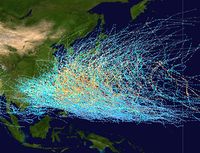Typhoon

A typhoon is a tropical cyclone that develops in the northwestern part of the Pacific Ocean between 180° and 100°E. For organizational purposes, the northern Pacific Ocean is divided into three regions: the eastern (North America to 140°W), central (140°W to 180°), and western (180° to 100°E). A Pacific typhoon, then, is a tropical cyclone in the northern Pacific Ocean west of 180°. Identical phenomena in the eastern north Pacific are called hurricanes, with tropical cyclones moving into the Western Pacific re-designated as typhoons.
Within the Northwestern Pacific there are no official typhoon seasons as tropical cyclones form throughout the year. The majority of storms form between May and December whilst tropical cyclone formation is at a minimum between January and April. The Northwestern Pacific features some of the most intense tropical cyclones on record.
Contents |
Etymology
The term Typhoon comes from the Standard Mandarin (simplified Chinese: 台风; traditional Chinese: 颱風; pinyin: Táifēng), meaning great (tái, 颱) and wind (fēng, 風, and in Japanese 台風 (tai-fu). In plural, one can add an "s" at the end in English although in Chinese, "Táifēng", as with "Taifu" in Japanese, is always pronounced the same for both singular and plural. [1]
Warning Centers
Within the Western Pacific the Japan Meteorological Agency's Regional Specialized Meteorological Center in Tokyo has the official warning responsibility for the whole of the Western Pacific. However each National Meteorological and Hydrological Service within the western Pacific has the responsibility for issuing warnings for land areas about tropical cyclones affecting their country.
Climatology
Nearly one-third of the world's tropical cyclones form within the Western Pacific. This makes this basin the most active.[2] Pacific typhoons have formed year round, with peak months from August to October. The peak months correspond to that of the Atlantic hurricane seasons. Along with a high storm frequency, this basin also features the most globally intense storms on record. One of the most recent extraordinary years was 1997.
| Most intense Pacific typhoons | ||||||
|---|---|---|---|---|---|---|
| Typhoon | Season | Pressure | ||||
| hPa | inHg | |||||
| 1 | Tip | 1979 | 870 | 25.7 | ||
| 2 | Nora | 1973 | 875 | 25.8 | ||
| June | 1975 | |||||
| 4 | Ida | 1958 | 877 | 25.9 | ||
| 5 | Kit | 1966 | 880 | 26.0 | ||
| Rita | 1978 | |||||
| Vanessa | 1984 | |||||
| 8 | Nina | 1953 | 885 | 26.1 | ||
| Joan | 1959 | |||||
| Irma | 1971 | |||||
| Forrest | 1983 | |||||
| Megi | 2010 | |||||
| Source:JMA Typhoon Best Track Analysis Information for the North Western Pacific Ocean.[3] |
||||||
| Month | Count | Average |
|---|---|---|
| Jan | 28 | 0.6 |
| Feb | 15 | 0.3 |
| Mar | 26 | 0.6 |
| Apr | 39 | 0.8 |
| May | 64 | 1.4 |
| Jun | 96 | 2.0 |
| Jul | 215 | 4.6 |
| Aug | 312 | 6.6 |
| Sep | 262 | 5.6 |
| Oct | 219 | 4.7 |
| Nov | 134 | 2.9 |
| Dec | 75 | 1.6 |
| Annual | 1484 | 31.6 |
| Source: JTWC[4] | ||
Actually the area of the Pacific Ocean known as the Federated States of Micronesia, (FSM) or Chuuk (formerly Truk) is the birthplace of 90% of all typhoons in the northern Pacific. The Shallows Seas in that area are easily heated, thereby creating the perfect conditions for spawning Typhoons. Citing the only known Typhoon spawned off the coast of Mexico which then wound it's way across the Pacific from Baja California, to Hawaii and then continued on to the Marshall Islands, Chuuk, Pohnpei, and having landfall directly on the island of Guam was Typhoon Paka-December 1997. This Typhoon then went on to hit the Philippines, Vietnam and Thailand before dissipating over Myannmar.
Paths

Typhoon paths follow three general directions.[2]
- Straight. A general westward path affects the Philippines, southern China, Taiwan, and Vietnam.
- Recurving. Storms recurving affect eastern China, Taiwan, Korea, and Japan.
- Northward. From point of origin, the storm follows a northerly direction, only affecting small islands.
If viewed at the starting point of these tracks with a political map overlay, the Islands of CHUUK are at the center of the initial starting points in this illustration.
Basin monitoring
The following agencies monitor typhoons:
- Joint Typhoon Warning Center
- Philippine Atmospheric, Geophysical and Astronomical Services Administration (PAGASA)
- RSMC Tokyo-Typhoon Center, part of the Japan Meteorological Agency
Name sources
The list of names consists of entries from 17 East Asian nations and the United States who have territories directly affected by typhoons. The submitted names are arranged into five lists; and each list is cycled with each year. Unlike hurricanes, typhoons are not named after people. Instead, they generally refer to animals, flowers, astrological signs, and a few personal names. However, PAGASA retains its own naming list, which does consist of human names.[5] Therefore, a typhoon can possibly have two names. Storms that cross the date line from the Central Pacific retain their original name, but the designation of hurricane becomes typhoon. In Japan and Vietnam, typhoons are simply numbered according to the sequence of their occurrence in the calendar year. Hence the third typhoon in a given year is simply "Typhoon No. 3".
See also
References
- ↑ http://www.yellowbridge.com/chinese/chineseloan.php
- ↑ 2.0 2.1 "Examining the ENSO". James B Elsner, Kam-Biu Liu. 2003-10-08. http://www.int-res.com/articles/cr2003/25/c025p043.pdf. Retrieved 2007-08-18.
- ↑ Japan Meteorological Agency (2010-01-12). "JMA Typhoon Best Track Analysis Information for the North Western Pacific Ocean" (TXT). http://www.jma.go.jp/jma/jma-eng/jma-center/rsmc-hp-pub-eg/Besttracks/bst_all.txt. Retrieved 2010-01-12.
- ↑ "2005 Annual Tropical Cyclone Report: Western Pacific". JTWC. 2005. http://www.usno.navy.mil/NOOC/nmfc-ph/RSS/jtwc/atcr/2005atcr/chapter1/chapter1.html. Retrieved 2007-08-26.
- ↑ "How typhoons are named". USA Today. 2007-11-01. http://www.usatoday.com/weather/hurricane/typhoon-names.htm. Retrieved 2008-08-18.